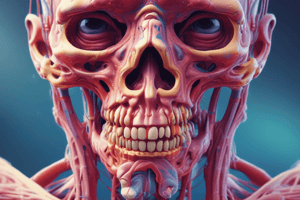Podcast
Questions and Answers
What causes cyanosis in newborns with respiratory distress syndrome?
What causes cyanosis in newborns with respiratory distress syndrome?
- Sufficient surfactant in the lungs
- Excessive oxygen supply to body tissues
- Proper ventilation of the lungs
- Inadequate oxygen supply to body tissues (correct)
What type of apnea can be caused by a blockage in the upper airway?
What type of apnea can be caused by a blockage in the upper airway?
- Cardiogenic apnea
- Central apnea
- Obstructive apnea (correct)
- Hypoxic apnea
What can be a potential cause of bradycardia in newborns with respiratory distress?
What can be a potential cause of bradycardia in newborns with respiratory distress?
- Hypoxia (correct)
- Increased heart rate
- Lung expansion
- Excessive oxygen supply
What does grunting in newborns with respiratory distress signify?
What does grunting in newborns with respiratory distress signify?
Why might hypothermia occur in newborns with respiratory distress?
Why might hypothermia occur in newborns with respiratory distress?
What is a common symptom of respiratory distress in newborns that involves blue discoloration of the skin due to lack of oxygen?
What is a common symptom of respiratory distress in newborns that involves blue discoloration of the skin due to lack of oxygen?
Which symptom of respiratory distress in newborns is characterized by periods of no breathing that last longer than 20 seconds?
Which symptom of respiratory distress in newborns is characterized by periods of no breathing that last longer than 20 seconds?
What is a common sign of respiratory distress in newborns characterized by a decreased heart rate below 100 beats per minute?
What is a common sign of respiratory distress in newborns characterized by a decreased heart rate below 100 beats per minute?
In the context of newborns, how can hypothermia be prevented?
In the context of newborns, how can hypothermia be prevented?
Which symptom of respiratory distress in newborns might indicate an increased energy expenditure during breathing and poor feeding?
Which symptom of respiratory distress in newborns might indicate an increased energy expenditure during breathing and poor feeding?
Study Notes
Distress in High Risk Newborns: Understanding Cyanosis, Apnea, Bradycardia, Grunting, and Hypothermia
High risk newborns, particularly those with respiratory distress, may present with various signs and symptoms, including cyanosis, apnea, bradycardia, grunting, and hypothermia. Understanding these conditions is crucial for prompt recognition and management in the neonatal period.
Cyanosis
Cyanosis is a bluish discoloration of the skin and mucous membranes due to an inadequate oxygen supply to the body tissues. This condition is commonly seen in newborns with respiratory distress syndrome (RDS), which occurs in premature infants due to a lack of surfactant in the lungs.
Apnea
Apnea, or the temporary cessation of breathing, can be a sign of respiratory distress in newborns. It may be central, originating in the brain, or obstructive, caused by a blockage in the upper airway.
Bradycardia
Bradycardia, or a slow heart rate, can occur in newborns with respiratory distress. It may be a result of hypoxia, or reduced oxygen supply, which can cause the heart to pump less effectively.
Grunting
Grunting is a forced expiratory sound heard in newborns with respiratory distress. This noise indicates that the baby is breathing against a partially closed glottis, which helps keep the alveoli patent and maintain oxygenation.
Hypothermia
Hypothermia, or low body temperature, can be a complication of respiratory distress in newborns. It may result from increased energy expenditure during breathing and poor feeding, or from inadequate heating in the delivery room.
Management
Management of respiratory distress in newborns involves addressing the underlying cause, providing supplemental oxygen, and using continuous positive airway pressure (CPAP) or mechanical ventilation, as needed. Surfactant therapy may be administered for RDS, and hypothermia should be prevented by maintaining a warm environment and providing adequate caloric intake.
Conclusion
Understanding the signs and symptoms of cyanosis, apnea, bradycardia, grunting, and hypothermia in high risk newborns is essential for timely recognition and intervention. Early management can help prevent progression to more severe respiratory failure and improve outcomes in these vulnerable infants.
Studying That Suits You
Use AI to generate personalized quizzes and flashcards to suit your learning preferences.
Description
Learn about the signs and symptoms of respiratory distress in high risk newborns, including cyanosis, apnea, bradycardia, grunting, and hypothermia. Understand the importance of prompt recognition and management of these conditions in the neonatal period.




